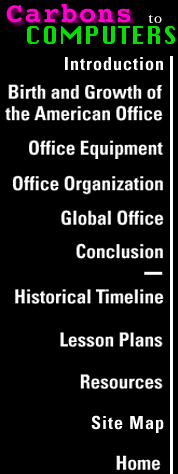
Office Workers
The first clerical workers were men. Early clerical work
was seen as a craft, developed to help business owners 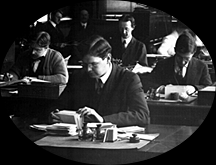 keep current records of their enterprises and to maintain relations
with the outside world. Apprentices or journeymen craftsmen learned their
crafts from master bookkeepers or chief clerks then advanced in the business
by promotion. Since clerks often rose into management positions, owners
tended to fill these entry-level slots with male family members.
keep current records of their enterprises and to maintain relations
with the outside world. Apprentices or journeymen craftsmen learned their
crafts from master bookkeepers or chief clerks then advanced in the business
by promotion. Since clerks often rose into management positions, owners
tended to fill these entry-level slots with male family members.
As the office developed in complexity and size, clerical
work was mechanized. The skills required to operate a typewriter or take
stenography differed increasingly from those required of managers. Women
were brought 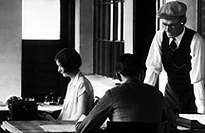 into offices to fill these new "clerical"
positions, with firms taking advantage of the supply of middle-class, high
school or college-educated women who would work for lower wages than men
of comparable education. As women were drawn into clerical work, the jobs'
contents changed. The previously masculine job of clerk, the first step
on the ladder to a management position, was transformed into a permanently
subordinate, and hence feminine, job.
into offices to fill these new "clerical"
positions, with firms taking advantage of the supply of middle-class, high
school or college-educated women who would work for lower wages than men
of comparable education. As women were drawn into clerical work, the jobs'
contents changed. The previously masculine job of clerk, the first step
on the ladder to a management position, was transformed into a permanently
subordinate, and hence feminine, job.
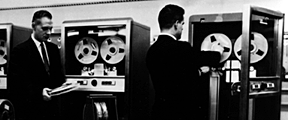
As we approach the twenty-first century, many women have advanced from secretarial jobs to management positions by talent, hard work, and determination. It is fair to say, however, that most clerical positions remain "permanently subordinated." But this is not to say that nothing has changed.
A major difference in today's work world from that of our
grandparents and great-grandparents is that women 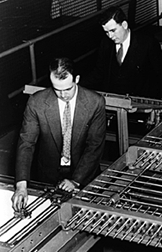 are not limited to a choice between clerical
and factory work if they are without education or skills, and between teaching
and nursing if they have advanced education. Both men and women work in
virtually all the professions.
are not limited to a choice between clerical
and factory work if they are without education or skills, and between teaching
and nursing if they have advanced education. Both men and women work in
virtually all the professions.
But again, these changes do not mean that being a man or a woman has no bearing on the kind of work a person will do. When we recall that the overwhelming majority of all professional positions were held by men at the beginning of the twentieth century, women's current career success represents their clear and steady progression into men's jobs. We do not see a similar rush by men to women's jobs, however. "Men's jobs" remain the favored choice.
No one could say with certainty which jobs will be held
by men, which by women, fifty years from now. We  probably are unable to imagine what the jobs will be, given the
rapid pace of technological change in modern life, let alone who will hold
them. But certain factors need to be considered when thinking about work
in the future.
probably are unable to imagine what the jobs will be, given the
rapid pace of technological change in modern life, let alone who will hold
them. But certain factors need to be considered when thinking about work
in the future.
Technological advances bring changes to the occupational
opportunities available to men and women. For example, many professionals
now work without secretarial support, using their own computers with word
processing  capabilities to write correspondence and reports,
using the computer to file information that formerly would have had to be
stored in a filing cabinet. Telephone answering machines and services already
replace receptionists and personal secretaries for many people. These factors
would tend to change or affect the traditional hierarchies of offices.
capabilities to write correspondence and reports,
using the computer to file information that formerly would have had to be
stored in a filing cabinet. Telephone answering machines and services already
replace receptionists and personal secretaries for many people. These factors
would tend to change or affect the traditional hierarchies of offices.
Subordinate work or support work will always be attractive to some segment of the population, if only at certain times in their working lives. Some women will continue to choose family over career, at least for a number of years. Many people work more than one job, or work while preparing for another career, and are attracted to support positions. And as the population ages, former careerists may choose to supplement pensions or augment volunteer work with part-time or temporary jobs. These millions of workers would tend to support the continuance of "noncareer" jobs in the corporate or office structure.
Finally, not everyone can be the boss or a professional, nor do they want to be. If everyone could be in charge, managers would have nobody to manage.